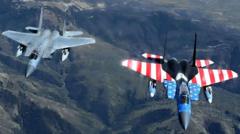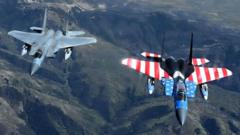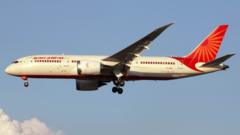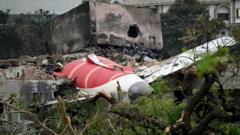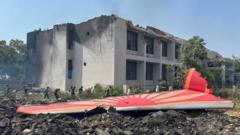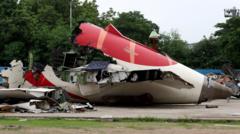The recent Air India disaster, which claimed at least 270 lives and involved a Boeing 787 Dreamliner, has ignited a renewed focus on the aircraft’s safety amidst longstanding allegations of quality control failures. This innovative jet, heralded for its fuel efficiency and design, has enjoyed a reputation for safety over nearly 15 years of service. However, whistleblower accounts reveal troubling production shortcuts that could compromise passenger safety. Investigations are ongoing to piece together the evidence from the crash as industry experts weigh the implications for Boeing's manufacturing practices.
Boeing 787 Dreamliner: A Triumph of Innovation or a Hidden Risk?

Boeing 787 Dreamliner: A Triumph of Innovation or a Hidden Risk?
In the wake of a tragic crash, questions surrounding the safety of Boeing's 787 Dreamliner resurface as whistleblower claims raise concerns over production quality.
Boeing's 787 Dreamliner was initially celebrated as the future of aviation, combining advanced materials and engineering prowess, until concerns about its production standards began to surface. Now, after the tragic loss of Flight 171, the aviation community—along with the families of victims—demand answers about potential flaws from a manufacturer already under scrutiny following past incidents.
The catastrophic crash of an Air India 787 Dreamliner, resulting in the loss of over 270 lives, has brought a cloud of uncertainty over Boeing’s flagship aircraft, renowned for its cutting-edge design and innovation. Until this incident, the Dreamliner was widely regarded as one of the safest aircraft flying today, with over a billion passengers transported without a major mishap in its operational history. While the precise cause of the Air India crash remains to be determined, investigators have begun analyzing recovered flight data, prompting experts to revisit concerns about manufacturing practices and quality assurance that have plagued the production of the 787 series.
Boeing's ambitious vision for the Dreamliner was to revolutionize long-haul travel during a time of escalating fuel costs. The introduction of this aircraft was intended to herald a new generation of energy-efficient and quieter flying technology. Nevertheless, behind its sleek exterior and progressive engineering lies a narrative entwined with allegations of regulatory oversight failures and pressure-laden production practices.
Investigations into past whistleblower accounts reveal a disconcerting landscape of production shortcuts and safety compromises. Former quality managers at Boeing have made alarming claims about the integrity of components, asserting that improperly vetted parts may have been incorporated into operational aircraft. An internal audit subsequently corroborated some of these claims, exposing gaps in manufacturing processes that could threaten flight safety.
As Boeing grapples with a crisis of confidence, the recent tragedy has revitalized scrutiny from regulators and the public. While Boeing maintains that enhancements to oversight and quality control procedures have been instituted, the road ahead appears fraught with challenges as it attempts to reassure a wary flying public. Current and former employees continue to voice their apprehensions, suggesting that lasting repercussions from manufacturing challenges could still linger and endanger flights.
The aviation industry anxiously watches as investigations continue into the causes behind the recent crash. Whistleblowers assert that safety risks must be thoroughly addressed, suggesting that the Dreamliner may carry underlying defects capable of resulting in future calamities. As Boeing works to restore its reputation in the wake of two major accidents within its fleet, the future of the 787 Dreamliner now hangs in the balance as it moves through a critical juncture of scrutiny, innovation, and accountability.
While industry leaders remain optimistic about the aircraft's long-term safety record, the sentiment among stakeholders is one of concern, compounded by the mystery surrounding the Air India crash. The proceedings will likely resonate through the halls of safety regulators and amongst passengers, as answers remain urgently sought in the quest for transparency and rebuilding trust in a vital sector of air travel.
The catastrophic crash of an Air India 787 Dreamliner, resulting in the loss of over 270 lives, has brought a cloud of uncertainty over Boeing’s flagship aircraft, renowned for its cutting-edge design and innovation. Until this incident, the Dreamliner was widely regarded as one of the safest aircraft flying today, with over a billion passengers transported without a major mishap in its operational history. While the precise cause of the Air India crash remains to be determined, investigators have begun analyzing recovered flight data, prompting experts to revisit concerns about manufacturing practices and quality assurance that have plagued the production of the 787 series.
Boeing's ambitious vision for the Dreamliner was to revolutionize long-haul travel during a time of escalating fuel costs. The introduction of this aircraft was intended to herald a new generation of energy-efficient and quieter flying technology. Nevertheless, behind its sleek exterior and progressive engineering lies a narrative entwined with allegations of regulatory oversight failures and pressure-laden production practices.
Investigations into past whistleblower accounts reveal a disconcerting landscape of production shortcuts and safety compromises. Former quality managers at Boeing have made alarming claims about the integrity of components, asserting that improperly vetted parts may have been incorporated into operational aircraft. An internal audit subsequently corroborated some of these claims, exposing gaps in manufacturing processes that could threaten flight safety.
As Boeing grapples with a crisis of confidence, the recent tragedy has revitalized scrutiny from regulators and the public. While Boeing maintains that enhancements to oversight and quality control procedures have been instituted, the road ahead appears fraught with challenges as it attempts to reassure a wary flying public. Current and former employees continue to voice their apprehensions, suggesting that lasting repercussions from manufacturing challenges could still linger and endanger flights.
The aviation industry anxiously watches as investigations continue into the causes behind the recent crash. Whistleblowers assert that safety risks must be thoroughly addressed, suggesting that the Dreamliner may carry underlying defects capable of resulting in future calamities. As Boeing works to restore its reputation in the wake of two major accidents within its fleet, the future of the 787 Dreamliner now hangs in the balance as it moves through a critical juncture of scrutiny, innovation, and accountability.
While industry leaders remain optimistic about the aircraft's long-term safety record, the sentiment among stakeholders is one of concern, compounded by the mystery surrounding the Air India crash. The proceedings will likely resonate through the halls of safety regulators and amongst passengers, as answers remain urgently sought in the quest for transparency and rebuilding trust in a vital sector of air travel.







